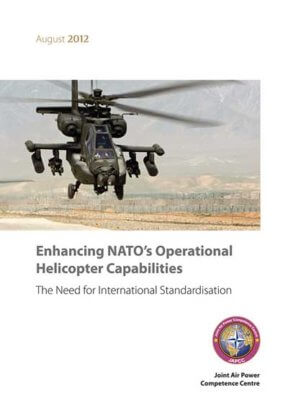Introduction
The recent Iraq and Afghanistan campaigns have highlighted the unique capabilities helicopters have contributed to the asymmetric environment. However, whilst playing a decisive part in successful operations, it has become increasingly clear to commanders that the shortfalls within the international helicopter community are constraining the overall mission as stated in the 2009 NATO BI-Strategic Commands Priority Shortfall Areas1.
The mentioned priority shortfall area can mainly be attributed to three principal issues: specific nations that were unable to deliver platforms (political or economical driven), limitations in the capabilities of crews/helicopters and deficiencies in international standardisation. The absence of in-theatre standardisation is symptomatic of the wider lack of international standardisation across NATO’s helicopter community leading to inefficient use of this resource in joint and combined missions.
With member States’ Defence budget cuts affecting the availability of helicopters, embracing NATO’s Smart Defence initiative2 will be a vital part of combating this lack of availability. Thus ‘Pooling & Sharing’ of assets and better coordination of our efforts will be important methods for resourcing future military operations in a multinational environment and will be a key to enhance NATO’s operational helicopter capability.
Aim
The aim of this document is to determine helicopter shortcomings in international standardisation, doctrine, and Education and Training (E&T) within the NATO environment; especially in Joint and Combined operations. This project will also provide recommendations to enhance future NATO helicopter capabilities in land operations. This will also detail the current complexities of stand-alone national doctrines and national Tactics, Techniques and Procedures (TTP’s). Finally, the study proposes enhancements necessary for a more collaborative approach.
Application / Project Description
After the publication of the Joint Personnel Recovery Primer in 2011, the JAPCC completed the initial phase of the Study on “Enhancing NATO’s Operational Helicopter Capabilities”. This Study reports that both the shortfall in operational capability in the international domain and the required Education/Training (including training structures) are not fully appreciated by a significant majority of NATO member states. It describes how international co-operation is hampered by an absence of international standardisation. This document will also provide advice to military commanders and staffs on how to improve standards required for multinational co-operation and provide innovative ways to address the future training requirement. It is designed to present the reader with thoughts on ways to enhance the effective use of NATO helicopters in international environments, particularly in complex land operations.
The data in this study was gathered from the NATO staff in Brussels, Allied Command Transformation, Air Component (AC) Ramstein, Helicopter Inter Service Work Group and many other national and international helicopter organisations. Also, an important part of this study was a questionnaire3 that was sent to the military staffs of a selection of NATO nations. In addition interviews with former International Security Assistance Force (ISAF) Regional Command commanders and the results of a JAPCC Air Forum4 are used. Nations and agencies that contributed to this project via the JAPCC Questionnaire and/or the JAPCC Air Forum are: Belgium, Canada, Czech Republic, Denmark, France (Air Force), Germany (Army), Great Britain, Greece, Hungary, Italy, Poland, Romania, Slovakia, Slovenia, Spain, The Netherlands, Turkey, USA (Army), AC Ramstein, the European Defence Agency (EDA) and the European Air Group (EAG).
Scope and Limitations
The JAPCC is aware of helicopter initiatives within NATO, the EDA and EAG. This publication will mention recommendations for improvement in a broad area of subjects. Nevertheless, this publication is by no means prescriptive.
European Union (EU). When the EU is mentioned, it is in the context of the 21 EU nations that are in NATO. These NATO/EU nations possess 95% of the combined helicopter and personnel assets in Europe (less Russia) and must use this same equipment and personnel for both NATO and EU tasks. EU helicopter forces that are not part of NATO are not covered in this document.
NATO Nations addressed. Not all NATO nations are addressed but for future projects the JAPCC intends to include all NATO nations that operate military helicopters.
Standardisation. When standardisation is mentioned it is focused on International Operational standardisation only. This does not include ‘national’ standards that are not involved in multinational operations i.e. basic training, flight currency, etc…
Logistics and maintenance. Although logistics and maintenance are key factors effecting aircraft availability, helicopter logistics and maintenance are primarily a national responsibility. There are several multinational logistic and maintenance initiatives in development however, not yet in the scope of this publication; therefore this publication will not discuss helicopter logistics and maintenance.
Navy and Marines helicopters. For simplicity, this study does not include Navy and Marine helicopter organisations. It is the intent of the JAPCC to include these organisations in future projects because of their growing involvement in land operations.
Littoral operations. Recent campaigns like Operation Unified Protector5, proved the effectiveness of helicopters in littoral operations but are not included in this document.
This is not an asset register. This document does comprise a limited6 catalogue of NATO Army and Air Force Helicopters. The intent is not to make an official register of all nations’ helicopters because a register would simply list a nation’s available military helicopter assets. The register in this study is used to indicate similarities between nations and give readers a basic comprehension of other nation’s helicopter formations that could lead to possible opportunities for cooperation.
Appreciations
The JAPCC offers their special appreciation to LtGen de Kruijf (NLD)7, BrigGen Wolski (DEU)8, and Air Commodore (Ret.) van Hoof (NLD)9 for their explicit valuable input.











